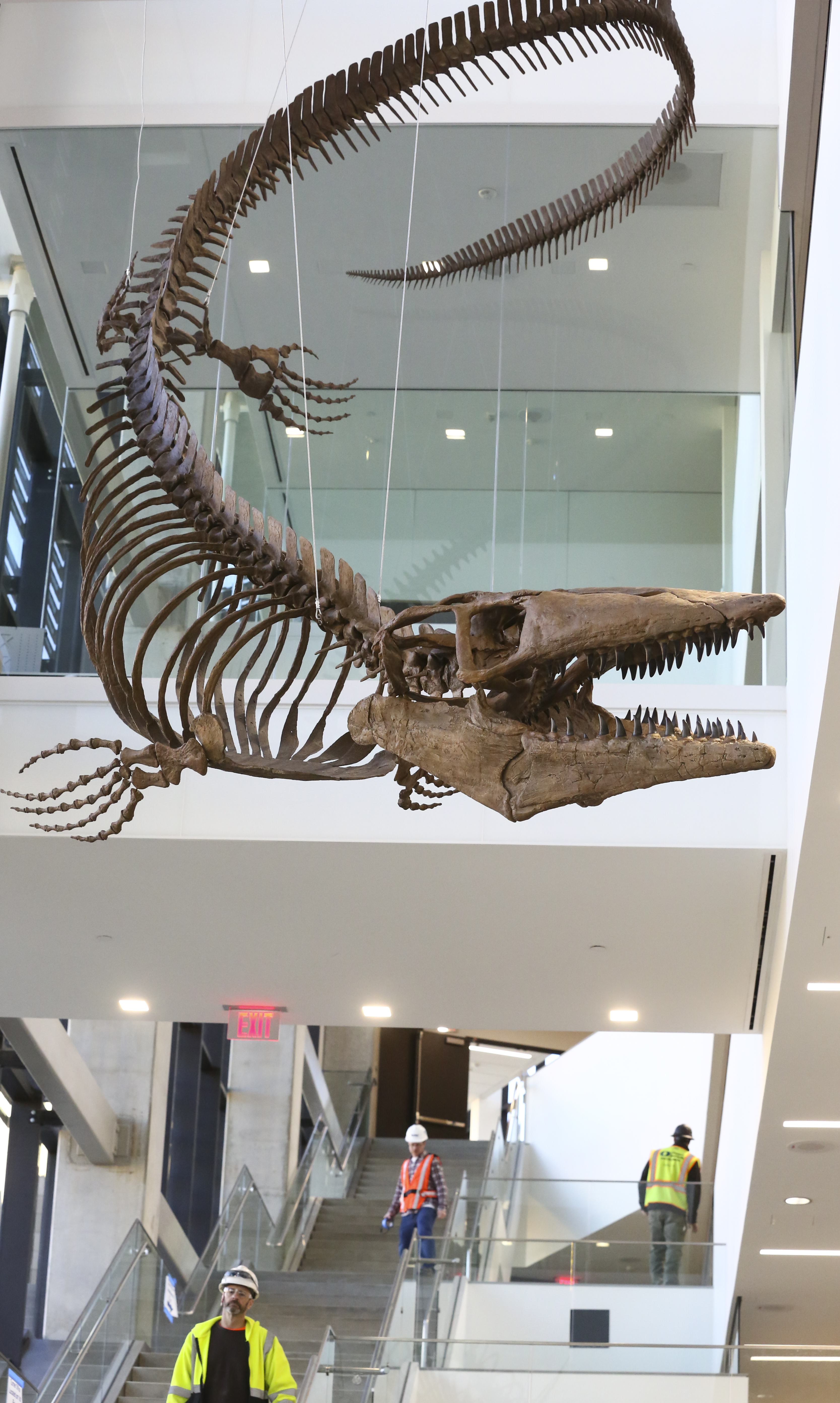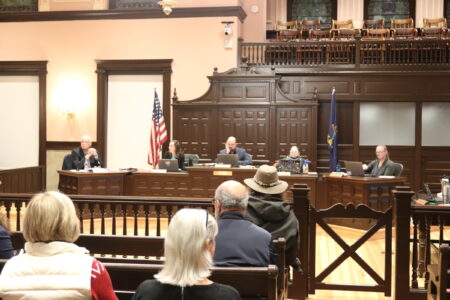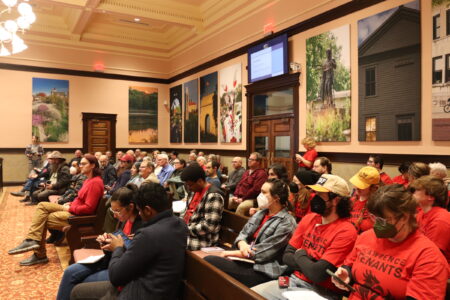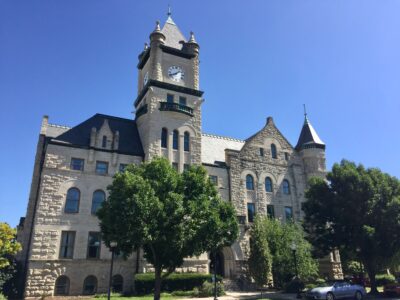Newly retired KU paleontologist looks back on 27 years of telling prehistoric creatures’ stories

photo by: Chris Conde/Journal-World
David Burnham presents a row of T. rex teeth on April 18, 2025, at the Paleontology Lab at Dyche Hall, 1345 Jayhawk Blvd.
For David Burnham, paleontology isn’t just a science — it’s storytelling, and the stories are written in ancient creatures’ bones.
Last week, he gave a performance of one of these prehistoric dramas for the Journal-World at the paleontology lab at the University of Kansas’ Dyche Hall. In a box is the fossilized skull of one of the players — a baby triceratops that he found in Montana. The skull has scratch marks on it from where another player, an adult Tyrannosaurus rex, was dining on it.
In his hand, he has the tooth of another T. rex — this one just a child. He puts it into one of the grooves in the triceratops skull to show how it fits.
The young T. rex was biting into another young dinosaur when it died — a baby eating a baby. It’s all there, in the scientific work that Burnham did to find and interpret these fossils.
He speculates that the grown T. rex had brought the triceratops back to the den “where they teach them how to fight, to play or just to feed” — and that the young T. rex was playing with it.
“Here, kids, play with this head while I go get dinner!” Burnham says.
“So it’s fun,” he goes on. “We get to tell a lot of stories. But what I tell the students, you can’t just have a story. You got to do the research. You got to find some physical evidence and prove it.”

photo by: Chris Conde/Journal-World
David Burnham shows how a baby T. rex’s tooth fits into a groove on the skull of a baby triceratops on April 18, 2025, at the paleontology lab at Dyche Hall, 1345 Jayhawk Blvd.

photo by: Chris Conde/Journal-World
A baby T. rex tooth on April 18, 2025, at the paleontology lab at Dyche Hall, 1345 Jayhawk Blvd.
This month, Burnham retired from his position as a vertebrate paleontology preparator at the KU Biodiversity Institute. He’s been a paleontologist for 27 years, and during his time at KU he took part in more than 50 expeditions into hills and deserts around the globe to look for these prehistoric beasts and tell their stories.
“It’s sort of like the monsters in your head,” he said of the animals he studies. “You find one of these things and it’s like, ‘Oh, wow. They’re real.'”

photo by: Chris Conde/Journal-World
T. rex teeth on April 18, 2025, at the paleontology lab at Dyche Hall, 1345 Jayhawk Blvd. Small teeth can be seen growing to replace larger teeth.
A ‘super-powered’ predator
The fearsome T. rex may be Burnham’s favorite dinosaur. As recently as the summer of 2024, he was back in Montana to look for more bones and teeth belonging to juvenile tyrannosaurs, as the Journal-World reported.
T. rex, which lived at the very end of the age of dinosaurs, is a superlative creature in many ways, Burnham said.
“They had the largest eyeballs of any animal,” he said. “Their sense of smell was outstanding. They could see two football fields away and had the strongest bite force on the planet. They could bite through a vehicle. They had the strongest hind limbs of any known animal. I mean, it just goes on and on and on, and in every sense it was super-powered.”
Given how powerful it was, it might surprise you to learn that the stories about T. rex preying on young and injured dinosaurs are a common genre in paleontology. We know what T. rex ate because there are fossils with the contents of the dinosaur’s last meal still inside its stomach, and in the T. rex, the most commonly found last meals are baby dinosaurs.
But this doesn’t surprise an expert like Burnham. This is a big creature that has to eat a lot, and most predators want to conserve energy by looking for easy meals — young, sick or otherwise weak animals.
“So big, bad T. rex ate babies,” Burnham said.
Though he enjoys studying them today, he’s also thankful that a certain asteroid intervened and that they’re not alive today. How might they have evolved further, and would they have terrorized our ancestors?
“Who knows where they would have went after that?” he said. “It’s a good thing they got wiped out. We might not have had a chance to evolve with things like the T. rex around.”

A 45-foot-long replica of a fossilized mosasaur skeleton is suspended from the ceiling of the main atrium in the new Earth, Energy and Environment Center at the University of Kansas on Thursday, Nov. 30, 2017.
A sea monster and a little thief
Burnham said that it was another giant beast that first brought him to KU in 1998: a monstrous aquatic reptile known as the mosasaur.
This creature has a special connection with Kansas — it lived here 80 million years ago, when Kansas was covered in water. A 45-foot-long mosasaur fossil that was discovered by C.D. Bunker and his associates from KU has long been part of the KU Natural History Museum collection, and a replica of it hangs in the KU geology building for good measure.
“They’re dinosaurs, but they’re not related to dinosaurs,” Burnham said. “They’re actually truly reptiles — whereas dinosaurs are birds, on that lineage or side of things — while these are more related to snakes and things like monitor lizards.”
Burnham finished his master’s degree in New Orleans before moving to Lawrence. He said he came to visit the mosasaur in KU’s collection and thought the city and university would be a great place to stay.
Initially, he camped at Clinton Lake for a time until he could get established financially. Soon, the researchers at KU gave him a bag of fossils to identify.
“When they brought it to me it was just a sack, so I had to clean it out of the rock,” he said. “It took 5,000 hours.”
But what emerged was his first major accomplishment at KU — “the most complete juvenile raptor ever found in North America.”
“We got published and named it ‘Bambiraptor,’ which means ‘baby thief,'” Burnham said.
Decades later, the bambiraptor is still a prized work of Burnham’s, on display at KU’s Natural History Museum. A replica of it has been made, too, and unlike the mosasaur, it’s clearly on the birdlike side.

photo by: Chris Conde/Journal-World
An artist’s rendition of a bambiraptor on April 18, 2025, at the paleontology lab at Dyche Hall, 1345 Jayhawk Blvd.
Inspiring other fossil hunters
Beyond the digging, writing and wonders of discovery, Burnham has also worked as a mentor to many KU students. However, he said he never taught formally in a classroom, but rather in one-on-one settings and while on expeditions.
“It was more fun for me to get the students involved, and I use the fossils as teaching tools,” he said. “If they wanted to work in the lab, they had to write a paper and learn how to do research. And they liked that, because they said, ‘Well, you’re the only professor to let us do research,’ because they’re undergrads.
“So I had a good following,” he said. “I had a whole army working for me.”
While working with students, he said he encouraged them to do what he did — do all the hard work, from start to finish, to see a project through.
“That was the biggest thing. A lot of people start things, but to finish them, it’s really hard. You got to fight boredom, you got to fight time. You have to complete the process.
“It’s not just good enough having neat thoughts,” he said. “It doesn’t count until you can actually write it down and publish it.”
Burnham may be officially retired, but his adventures are far from over. He’ll soon be a grandfather, and he still plans to travel the world — and he’ll also still be working with KU from time to time as an associate researcher, which will allow him to keep doing what he loves without devoting all of his time and energy to it.
He said he will also continue to help with recruiting donors for the department so KU researchers can continue their work the way he has throughout his career, with dollars donated by people as passionate for the work as the researchers themselves.
The opportunities KU has given him over the last 27 years are greater than he could have ever dreamed of, he said.
“Some major paleontologists have never found a T. rex or a dinosaur in their life,” he said. “They may go out every now and then, but the opportunity I’ve had at KU to go out sometimes three times a year and just do this work and bring it back, to have this big lab to work on it. And KU has got, what, four libraries on campus? I had access to any journal I wanted.
“Now, I’ve been to China six times,” he said. “France, Germany a couple times, Canada, Mexico, I’ve been around the world. And I love to share it with students, avocationalists, volunteers. Anyone who wants to talk dinosaur, I’ll talk dinosaur.”

photo by: Chris Conde/Journal-World
David Burnham surveys a drawer of fossils on April 18, 2025, at the paleontology lab at Dyche Hall, 1345 Jayhawk Blvd.






